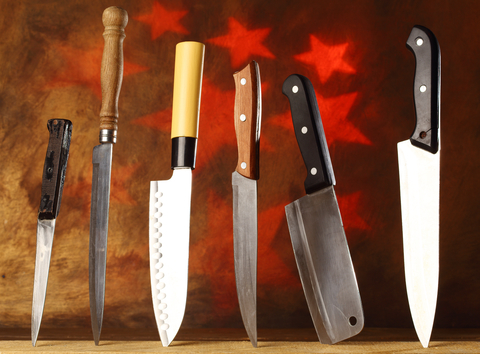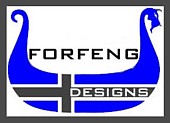Knife Knowledge for the Bed and Breakfast Owner and Innkeeper

Knives have come a long way since I graduated from the Culinary Institute of America in 1992, plus there are a lot more brands out there that were not available than. Ask any professional chef or anyone else that loves cooking, whether for pleasure or for a profession, you will get a completely different answer as to the best knives, the best brands and their favorite type of knives. So this article aims to be more informational than opinion, so that the reader can choose their own with more direction.
I personally have always had (and still have) primarily Wüsthof and Henckels (J.A. Henckels) knives, and Dexter (Dexter Russell) for the ones I can badly abuse. My original knives that I used while cooking professionally, I still have almost all of them (several many inches shorter due to years of sharpening-photo above of many of them) with the exception of a boning knife that met a sad end when my husband snapped the tip off (he has since replaced it for me, such a sweet guy). A good knife lasts for a very very long time with TLC, and it’s something to keep in mind when shopping for knives, because you might go into some sticker shock looking at good quality ones, “Just HOW much is that paring knife????”. A good knife will last you decades, and can be kept in the family for many generations. I still have a Wüsthof utility (paring) knife that my Grandfather bought back in the 1920’s before he immigrated from Norway to America, and it’s still a great knife, and it still holds an edge.
Knives are a matter of preference. A lot like a car, there are certain things you want to look for when knife shopping. I would suggest adding to your knife collection slowly. Sets are great, but either you outlay a huge amount of money for a good set, of which you will realistically only use half of the knives a lot, and the others rarely, if at all, or you buy an inexpensive set and you get what you pay for, OR you can think about what you actually need, and invest in them slowly, which is what I would recommend.
Knife Storage:
Storing your knives properly is very important, if you must keep knives in a drawer, I would suggest either getting a custom rack insert for the drawer, or buying plastic knife guards for your knives.
Wood block storage is also very popular for knives; the two things I would caution users about is: don’t, under any circumstances, put your knives away wet, while wood doesn’t hold bacteria as well as plastic, if you do get any type of food contaminant or other particles in the holes you can have problems. When placing knives into the block and removing them, make sure you sheathe and unsheathe the knives with the blunt edge of the top of the knife coming into contact with the knife slot, and not the sharp side. This will help maintain sharpness.
My personal favorite for knife storage is a wall mounted magnetic strip, you can see all your knives at a glance and the risk of them dulling while coming into contact with something else is minimized. The magnets are strong, so be careful when placing your knifes on the rack, as improper placement can also cause some damage.
Some basic rules for knives:
- Always dry your knives after use.
- Never put them in the sink if dirty, or in a sink filled with water. (while this is common sense, I’ve lost count of the number of B&Bs (and sadly restaurant kitchens as well) I’ve visited that have been guilty of doing this.) While it’s not only extremely unsafe, you risk causing damage to your knives.
- After sharpening a knife, rinse well before use. I prefer washing it and than drying it, but don’t go directly from sharpening to cutting, at least wipe it down if nothing else.
- Keep your knives sharp! A dull knife will cause more damage and rip the skin if you cut yourself, vs a clean cut from a sharp knife which will heal faster and cleanly.
- Never put your good knives in the dishwasher! The wash cycle in a dishwasher vibrates silverware against your knives and contributes to dulling. It can cause delamination of some types of handles, and cause rivets to come off or loosen contributing to unsafe knives, plus most dishwashing liquids, detergents or pods contain caustics ingredients which can damage and pit your knives.

(Look at the above stock photo, look at the knife on the far right side, a rivet is missing and the handle is cracked, leading to an unsafe knife, as the partial detachment from the tang could result in the knife coming apart during use. The crack can also harbor food particles and bacteria.) You should never do this to your knives, even good quality ones can break a knife tip doing this.
Things to look for when knife buying:
The Tang: I really recommend buying full tang knives. Over many years, using other’s knives or “house” knives (what many professional kitchens have for cooks in addition to their own), I’ve found that knives with partial tangs have a short shelf life, they break and they are dangerous when the adhesive that connects the knife tang with the handle comes apart, especially if it’s being used at the time. I’ve seen many stitches as a result of injury’s caused by partial tang knives literally disintegrating while being used. I recommend meandering over to Lansky Sharpeners, who has a very good overview of knife tangs.
The Grip: the grip is a preference, what is it made of? Plastic, rubber, steel, in some cases cork and other materials. Make sure when you buy a knife, especially a Chef’s knife that you will use for chopping, the handle fits well in your hand and is comfortable, I was never a big fan of Victorinox knives (and they are great knives) because I have smaller sized hands, and the handles never felt very comfortable to me, again it’s a personal preference. Wood grips on knives tend to not hold up well under long term use. When knife shopping you may find a better price online for the knife you want and buy it there, but I’d suggest handling them first so you can see what it feels like in your hand and the balance.
Ever sharp knives: to own or not to own. I admit we have several in my house, I rarely use them but my husband does. If you want low maintenance knives, then yes these are the knives for you, but they are not “really” forever sharp. They do dull with repeated use, and you can’t re-sharpen them easily, sometimes not at all.
Riveting and Joins: When buying knives look for the joins and rivets, and see if the handle moves at all when you push the blade sideways. Good quality knives will have zero give, but many generic knives out there, while they look nice, are quite flimsy and not made for heavy duty use.
What are they made of?
Carbon Steel: this the traditional material used the most for the past few hundred years. It can hold an extremely sharp edge, but it does discolor easily. It will discolor some foods, like onions and citrus, as well as you can actually smell what seems like a chemical odor coming from it, and may leave a metallic taste. This doesn’t mean you shouldn’t use Carbon Steel with these, but it does mean that the acidity in onions and citrus can cause pitting of the blade, if you do use them, wipe the blade down every few minutes in between uses. I find if you are cutting a lot of meat or filleting fish, a carbon steel knife, I personally find, will do a better job as it’s holds an edge the best. Rubbing the blade down with a paste made from water and baking soda when you first get it (and repeat for the first few weeks) helps protect the knife and build up a good patina. Carbon steel knives will change color with use.
High Carbon Stain Free Steel: This is a relatively new alloy that combines the best features of Carbon Steel and new modern alloy metals (Chromium-Molybdenum Steel). Most modern higher end knives are made of this and it’s suggested for professional use.
Stainless Steel: this will not rust or corrode, but is a very poor choice for knives, it’s brittle and it is difficult to keep a very sharp edge on a stainless steel knife.
Ceramic Cutlery: This is a newer process made with modern age ceramics, often zirconium dioxide. Ceramic knives are substantially harder than steel knives, they will not corrode and work well for slicing vegetables, meat (boneless), fruits and bread. The downsides to ceramic, is it’s just like a plate, if it gets dropped, it can shatter or chip. Ceramic knives are not recommended for use with hard to cut items, like bones or frozen foods. While ceramic holds an edge a lot longer than carbon steel, once the edge degrades it needs a professional to re-sharpen it.
Damascus Steel: This is not “true” Damascus, that art has been lost for a long long time, these knives are basically laminated pieces of steel together, and quality can vary a huge amount depending on the maker. If you have a magnetic knife strip that can display your knives where your guests can see them, you will have the oh and ah factor, as they can be quite beautiful, but most of these knives will not outperform a regular good quality knife.
Some Quality Knife Brands:
Aritsugu http://aframestokyo.com/aritsugu.html (there are other sites out there that carry Aritsugu, the Aritsugu site itself is in Japanese).
Global http://globalknives.uk/
J.A. Henckels http://www.zwillingonline.com/
Masamoto http://www.masamotochefknives.com
Messermeister https://www.messermeister.com/
Shun https://shun.kaiusaltd.com/
Victorinox (formerly R.H. Forschner by Victorinox) https://www.victorinox.com/global/en_US/
Wüsthof http://www.wusthof.com
Honorable Mentions (great for knifes that can take some abuse, inexpensive and good for general purpose knives)
Dexter Russell http://www.dexterrussellcutlery.com/
Additional Knives:
MAC https://www.macknife.com/ (While reputedly a great knife brand, Thomas Keller and Charlie Trotter apparently love the line, the quality does seem to be there and it shows well in use.) I can’t say with certainty that this knife line will hold up well under long term use. I’ve test driven several of these, but unlike any of the above knife brands that I have used over the course of many many years, this one is a newer addition to the traditional brands. If you do decide to buy one of these, I would suggest the MTH-80 Professional over the TH-80 Chef Knives. The MTH-80 while the more expensive, is the better knife.
If anyone has any interest, I can do a follow up post on this with a suggested list of what to buy (or at least start out with) if you are just buying a bed and breakfast and need to stock the kitchen with equipment.
And an additional article with some useful tips 25 Tips And Tricks About Chef’s Knives- Every Chef Should Know.
